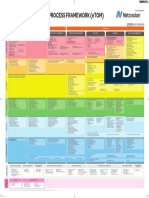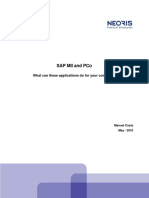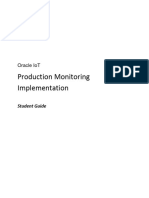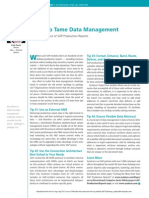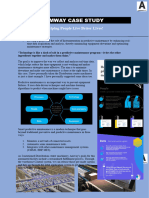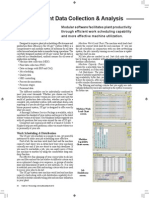Professional Documents
Culture Documents
Ampla at A Glance
Uploaded by
Rodrigo MirandaOriginal Description:
Original Title
Copyright
Available Formats
Share this document
Did you find this document useful?
Is this content inappropriate?
Report this DocumentCopyright:
Available Formats
Ampla at A Glance
Uploaded by
Rodrigo MirandaCopyright:
Available Formats
Commercial in confidence.
1
Ampla V4.0
at a Glance
Commercial in confidence.
2
2008 Citect Pty Ltd ABN 88 001 158 854
All rights reserved
Due to continued product development, this information may change without notice. The
information and intellectual property contained herein is confidential between Citect Pty Ltd and the
client and remains the exclusive property of Citect Pty Ltd. If you find any problems in the
documentation, please report them to us in writing. Citect Pty Ltd does not warrant that this
document is error free.
No part of this publication may be reproduced, stored in a retrieval system, or transmitted in any
form or by any means, electronic, mechanical, photocopying, recording, or otherwise without the
prior written permission of Citect Pty Ltd.
Citect Pty Ltd
Street Address: 3466 Pacific Highway, Springwood, QLD 4127, Australia
Postal Address: PO Box 2173, Logan City DC, QLD 4114 Australia
Tel: +61 2 9496 7300
Fax: +61 7 3209 5533
Email: info@citect.com
Website: http://www.citect.com
Commercial in confidence.
3
Table of Contents
TABLE OF CONTENTS .................................................................................................................... 3
WHAT DOES AMPLA DO? ............................................................................................................. 4
WHAT IS THE AMPLA ARCHITECTURE? .......................................................................................... 6
HOW DOES AMPLA INTEGRATE WITH AUTOMATION SYSTEMS? .................................................... 8
CAN YOU TRUST YOUR DATA WITH AMPLA? ................................................................................. 9
WHAT IS AMPLA STUDIO? .......................................................................................................... 10
WHAT IS AMPLA PRODUCTION ANALYST? .................................................................................. 11
WHAT ARE THE AMPLA OPERATOR CLIENTS? .............................................................................. 14
WHAT IS AMPLA DOWNTIME? ................................................................................................... 15
WHAT IS AMPLA PRODUCTION? ................................................................................................. 18
WHAT IS AMPLA METRICS? ........................................................................................................ 20
WHAT IS AMPLA INVENTORY? .................................................................................................... 22
WHAT IS AMPLA QUALITY? ........................................................................................................ 24
WHAT IS AMPLA PLANNER AND RECIPE? .................................................................................... 25
WHAT IS AMPLA KNOWLEDGE? .................................................................................................. 27
AMPLA MAINTENANCE? ............................................................................................................. 28
WHAT IS AMPLA COST? .............................................................................................................. 30
WHAT IS AMPLA REPORTING? .................................................................................................... 31
WHAT IS AMPLA PLANT2BUSINESS? ........................................................................................... 31
WHAT ARE AMPLA NOTIFICATIONS?........................................................................................... 32
CAN AMPLA SUPPORT A GLOBAL COMPANY? ............................................................................. 32
HOW DO YOU CARE FOR YOUR AMPLA? ..................................................................................... 32
LIST OF ACRONYMS AND ABBREVIATIONS .................................................................................. 33
Commercial in confidence.
4
What does Ampla do?
Ampla acquires and publishes operational performance information in a rich, consolidated format.
The Ampla system eliminates double handling of data and provides information in a responsive and
timely manner. Wherever possible, Ampla acquires data automatically. However, operators can also
enter data manually. Ampla exposes the business rules in a configuration environment and does not
hide them in proprietary systems software code. This aspect ensures long-term maintenance and
enhancements to the system can be managed by suitably trained site personnel.
Ampla Downtime enables plant managers to make continuous efficiency improvements by analyzing
production downtime causes. With this information, managers can prioritize maintenance, new
equipment, and new operating procedures. By reporting on both scheduled and unscheduled
downtime events, as well as underperforming equipment, Ampla Downtime breaks down seemingly
complex issues to common causes.
Ampla Production enables plant managers to see an accurate overall picture of the inputs and
outputs of the plant, including materials, consumables, energy, waste, emissions, reject and product
output. This information enables management to make better, more informed decision-making for
improved process efficiencies. Ampla Production enables you to minimize the amount of time,
errors, and costs associated with manual and duplicate data entry. Ampla Production captures an
accurate picture of production through the automatic real-time logging and provides a single point-
of-entry for manually entered production values.
Ampla Metrics draws data from other Ampla modules to calculate real-time Key Performance
Indicators (KPI) and present this information visually in a graphical dashboard display. Ampla Metrics
shows instantaneous measures such as Overall Equipment Effectiveness (OEE), Yield, and Energy
Consumption per Output Unit. Additionally, Ampla Metrics can show the trend of these measures
over time so that management can gauge the effect of improvement initiatives or operational
changes.
Ampla Inventory gives you the visibility to understand your work-in-progress and to know the real
cost of your inventory. It collects data about the quantity, movement, and storage of plant-side
materials, and provides the means to manage and track your inventory and material movements,
which gives you control over your production and costs.
Ampla Quality delivers automatic, real-time qualitative data directly from the production control
system to enable key decision makers to better analyze, report, and manage product quality
throughout the manufacturing cycle. The delivery of more timely and accurate reports allows better,
more informed decision-making for improved output quality and control.
Ampla Planner bridges the gap between the Enterprise Resource Planning (ERP) system and the
plant floor. This module provides production supervisors and planners with an online visualization
tool for scheduling production orders, planned maintenance activities, and standby periods to
achieve the most efficient use of the available plant, equipment, and resources.
Ampla Recipe provides support for implementation of the S.88 Batch Control standard. You can
create and maintain recipes in Ampla Recipe and when you select production or process orders for
execution, Ampla downloads the parameters to plant automation systems.
Commercial in confidence.
5
Ampla Knowledge ensures you have a complete picture of how your business is performing by
capturing important information and knowledge from the people who are closest to the plant. The
online diary, which acts as an operator's logbook, creates a central bank for information about
incidents that affect production, such as information about deliveries, unusual equipment set ups,
and other miscellaneous information. The diary features a sketchbook to include visual records as
well as text. Ampla Knowledge also features a reference library so that plant personnel can
immediately find information they need, such information as photographs of plant and equipment,
operating procedures, drawings, diagrams, and manuals.
Ampla Maintenance ensures you receive the optimal performance from your business equipment
by collecting essential data about asset operation and maintenance. Ampla displays this data
graphically for management to analyze and optimize operations. You can also upload data to
Enterprise Asset Management (EAM) systems for maintenance planning and scheduling.
Ampla Cost empowers you to track the real costs of your business by providing greater visibility into
your financial data. The module does not replace existing financial packages, but enhances the
usability of the data produced by these packages and making the information more relevant to the
user.
Commercial in confidence.
6
What is the Ampla Architecture?
Architecture Patterns
A high-level conceptual view of Ampla architecture (see Figure 1) shows that it follows a standard
three-tiered pattern that comprises the following layers:
Data layer
This layer consists of an abstracted data model for Ampla data storage and the sub-system
for tag-based connectivity.
Business layer
This server-side layer implements Manufacturing Execution System (MES) functionality in
distinctive modules.
Visualization and Integration layer
This layer provides the means by which users interact with Ampla, such as for data
presentation and analysis.
Figure 1 High-level view of Ampla architecture
Commercial in confidence.
7
From Data to Knowledge
A good way to understand the Ampla architecture is to picture the flow of information from a
hardware device to an end user. Irrespective of its source, most Ampla data follows this lifecycle:
1. Proprietary technology creates data; for example, programmable logic controller (PLC)
hardware, third party software or an industry standard communications protocol.
2. Specialized drivers (shipped with Ampla) extract the proprietary data from different data
sources in real-time as it becomes available.
3. The Ampla Connector Architecture transforms proprietary data into standardized Ampla
data samples.
4. Ampla places the data samples into historical streams. These streams synchronize multiple
data sources and inputs in an accurate chronological sequence.
5. The core data processing components of Ampla apply specific MES algorithms to the
historical streams according to the project configuration. These real-time or near real-time
algorithms derive module-specific information from the historical data samples.
6. Ampla uses one of its specialized data adaptors to store the new MES-specific data
information in the data repository.
7. When the information is in the data repository, it is available for use by the visualization and
integration components. The time elapsed from when proprietary technology created data
to the first time a user can view the data is typically less than 30 seconds.
Commercial in confidence.
8
How does Ampla integrate with automation systems?
Ampla integrates with automation systems through the connector architecture (see WHAT IS THE
CONNECTOR ARCHITECTURE? for more details). Ampla reads from and writes data to automation systems
through these connectors.
Ampla has the following automation system connectors:
OPC-xx The OPC-xx connectors (DA, HDA, and AE) supports the acquisition of data from
any OPC server that implements the mandatory feature set of these standards for the
supported versions (see SYSTEM REQUIREMENTS for more details).
CitectSCADA The CitectSCADA connector supports the acquisition of data from
CitectSCADA v5.42 or later. CitectSCADA v7 added server-clustering technology to its
features, and development is currently underway for Ampla to support CitectSCADA tags
that are on clustered servers (see www.citect.com for more details about CitectSCADA).
CitectSCADA is a system with a primary function of collecting information (data) and
providing an interface to control specific equipment such as Programmable Logic Controllers
(PLCs) and Remote Terminal Units (RTUs).
PI The PI connector supports the acquisition of data from OSIsofts PI System product (see
www.osisoft.com for more details). The OSI PI System is a historian with visualization
capabilities.
InSQL The InSQL connector supports the acquisition of data from a Wonderware Historian
9.0, formerly called the IndustrialSQL Server (see us.wonderware.com for more details).
Ampla also has the following connectors:
OLE DB The OLE DB connector supports the acquisition of data from OLE DB providers,
such as an Oracle database, Microsoft Access database, Microsoft SQL Server, and DB2
database. OLE DB provides uniform access to unstructured data regardless of type or
location on the network.
File The File connector supports the acquisition of data from text files placed in a folder.
Message Queue The Message Queue connector supports the acquisition of data through
the Microsoft Message Queue (MSMQ) infrastructure.
Commercial in confidence.
9
Can you trust your data with Ampla?
You can trust your data with Ampla. Ampla employs three different tactics to accomplish this:
securing your data, auditing your data, and configuration.
Building trust by securing your data
Ampla uses role-based security (using Microsoft technologies) that focus on defined roles and their
associated permissions to allow the right people the right access to the right data. A role-based
security model allows for simpler security management and by defining who can see and modify
what data.
The Ampla security model consists of the following concepts:
Operations - describe the tasks that users can perform in Ampla
Roles - a defined set of operations based on job or task descriptions
Role Assignments - enables you to associate plant hierarchy locations with a role and a user
Windows integrated security - when configured, Ampla does not require users to enter
password for users to login to its applications. Ampla can detect which Windows NT account
the user logged into the machine as and based upon that, determine the correct Ampla user
Guaranteed identity - Ampla can require the user to be re-authenticated, by re-entering
their password (NT password or an Ampla custom one) before the edits are saved.
Building trust by auditing your data
Ampla creates an audit trail (what data changed, when, and by whom) every time a record changes.
Ampla ensures all information in the audit trail is up-to-date so auditors have access to all
information and can react to concerns as soon as possible to combat fraud and minimize risk.
Building trust into your data
To ensure that your data is trustworthy, you can base the configuration of an Ampla Metrics KPI on
trusted data. You can configure Ampla Metrics to calculate a KPI on confirmed records only.
Confirmed records are those that authorized users have approved the record details as correct and
accurate. Similarly, Ampla can be configured to send only confirmed records onto external business
systems (for example, ERP or EAM) using Ampla Plant2Business.
Commercial in confidence.
10
What is Ampla Studio?
Ampla Studio is the configuration tool for configuring an Ampla Project.
Backup and Restoring Ampla Projects
Project designers can spend many hours configuring your Ampla Project so that it is just right. You
would not want the computers hard drive to crash and lose all of that work. Ampla Studio enables
you to back up the Ampla Project into a single file (only the configuration and not the data
repository). This facilitates quick and easy backups that you can store off site. A single backup file
also enables you to transport project configurations to different computers.
Can Ampla validate my configuration?
Each item in the Ampla Project has a set of rules that specify its correct configuration. Ampla Studio
gives the person who is configuring the system the option to validate the Ampla Project. Ampla
Studio displays any errors in configuration in the output window. An example of a validation error
would be a capture condition that does not have a defined expression.
Does Ampla have best practices for configuration?
Ampla has a library of technical articles that detail how to best configure the Ampla system to
maximize performance and create the lowest possible total cost of ownership.
How does Ampla reduce configuration time?
Ampla Studio has multiple ways in which you can reduce the time to configure an Ampla Project.
Here are some examples.
Copy and Paste Ampla Studio supports copying of items (and its children) and pasting them
under other items. This is especially helpful for configuring multiple production lines. You
can copy, paste, and rename a configured production line to create another complete with
reporting points.
Standard Fields Each Ampla module has a predefined set of fields that are useful for
analysis when capturing data.
Configuration Helpers Ampla Studio has a set of configuration helpers that remove the
tedious tasks of data entry (for example, importing the relevant tags from SCADA/OPC).
Commercial in confidence.
11
What is Ampla Production Analyst?
Ampla Production Analyst is a feature-rich configurable tool that provides high-level summary
displays with full drill-down capabilities to the raw data beneath. This facilitates root-cause analysis
as well as assisting in the identification of performance improvement opportunities. Ampla
Production Analyst has full filter, search, reporting, and diagnostics capabilities. You can navigate
your project by using an explorer tree that typically mimics the physical hierarchy of the plant.
Users can access Ampla Production Analyst through the Windows desktop or the Ampla Web Portal.
Ampla Production Analyst presentation data is through a layered set of views. The top view is the
Ampla Metrics Dashboard. The next level of view is the more detailed view associated with the data
collected for each particular Ampla module.
Ampla Production Analyst, shown in Figure 2, is comprised of the following components:
The Plant Hierarchy Tree pane
The Toolbar
The Module bar
The Filter Criteria pane
The Data Grid pane
The Charting pane
Figure 2 - Ampla Production Analyst user interface
Commercial in confidence.
12
Navigating Your Data
Ampla Production Analyst allows three different methods for navigating your data:
By location in the plant hierarchy
By product
By cause location (in the plant hierarchy and only for Ampla Downtime)
Filtering Your Data
Three different elements filter the displayed data in Ampla Production Analyst:
Which module is selected
Which location is selected
A custom filter
Viewing Your Data
The data grid view displays the data in a tabular arrangement as individual records.
The grouped grid view displays the data based on grouping criteria selected by the user
Clicking the heading of a column sorts the data within the grid by that column
The user can change the order of the columns by dragging and dropping columns.
Users can view a graphical representation of the information in the grid to enhance interpretation
and visualization. You can select different graphs to display from the Chart toolbar
What are Ampla Favourites?
Much like Microsoft Internet Explorer favourites and homepage features, Ampla Favourites are a
way that users can save and load Ampla Pages for quick access. This includes charting options and
grid layout.
An Ampla Homepage is the same as an Ampla Favourite except that it is immediately loaded
when the user starts Ampla Production Analyst.
Ampla Favourites have names, and you can use folders to organize them.
Selecting the Ampla Favourite will load the Ampla Page within Ampla Production Analyst.
Commercial in confidence.
13
Editing Your Data
In Ampla Production Analyst, users can edit the collected data and perform the following functions
on the data:
Adding records
Editing records
Deleting records
Confirming records
Un-confirming records
Copying data
Pasting data
Reconnecting to the Ampla Server
If Ampla Production Analyst determines that it is no longer connected to the Ampla Server (due to a
network outage or the Ampla Server being restarted), then it continually tries to re-establish a
connection. The user does not need to re-enter their credentials because Ampla Production Analyst
reuses the original ones.
If Ampla Production Analyst loses connection to the server because the Ampla Server is undergoing
an upgrade, a message appears and Ampla Production Analyst shuts down.
Commercial in confidence.
14
What are the Ampla Operator Clients?
Currently Ampla supports two standard operator clients:
Ampla Standard Operator Client
Ampla Touch Screen Operator Client
The Ampla Standard Operator Client
The Ampla Standard Operator Client is a Web application targeted at shop-floor workers who need
only the simplest of features when entering data about downtime events (see WHAT IS AMPLA
DOWNTIME? for more details).
The Ampla Touch Screen Operator Client
The Ampla Touch Screen Operator Client is a Web application that targets shop floor workers who
need only the simplest of features when entering data about downtime events (see WHAT IS AMPLA
DOWNTIME? for more details). It also targets areas in the production environment that do not allow
keyboard and mouse to be present. The Ampla Touch Screen Operator Client requires the use of
touch screen enabled monitors.
Commercial in confidence.
15
What is Ampla Downtime?
Ampla Downtime ensures your production facility is operating at its peak efficiency by identifying
where, how, and why production delays are occurring.
By reporting scheduled and unscheduled events, as well as underperforming equipment, Ampla
Downtime enables a complete analysis of production downtime causes. This gives you the
information you need to prioritize maintenance, order new equipment, and improve operating
procedures.
The automatic capture of downtime events frees operators from paperwork and removes the
inaccuracies and inconsistencies of manual systems.
What it means for you
Business managers can compare the downtime events of multiple plants and make
knowledge-based decisions to increase productivity.
Plant and production managers can prioritize maintenance and the purchase of new
equipment, revise operating procedures to optimize uptime, and continuously improve
facility effectiveness.
Ampla Downtime in more detail
Ampla Downtime facilitates the capture of downtime information, which is an important indicator of
production performance and reliability. Downtime is time during which production has stopped or
production is below a specified target rate. Recording the root cause of production downtime is the
first step to reducing production losses. You can use this information to identify the root cause of
lost production and the impact of production stoppages.
Ampla Downtime consists of the following core functions:
Data collection Automatic record creation on occurrence of a downtime event or manual
entry.
Editing and validation Adding of additional downtime details and downtime event
confirmation through the client interface.
Information view and analysis Data presentation for analysis.
Ampla Downtime defines downtime as the following types:
Real Downtime Time production has actually stopped.
Commercial in confidence.
16
Virtual Downtime Time when production is below user-defined threshold or below user-
defined specification, but production has not stopped.
Masked Downtime A mechanism for limiting the reporting on duplicate downtime events.
Limiting the valid Cause Locations
You can configure Ampla Downtime to limit the number of valid cause locations. This reduces the
amount of input required of operators and minimizes errors. You can base a reduced list of available
cause locations for a downtime event on the following:
The location where the downtime event was recorded (static list of locations).
The event or alarm from SCADA that is associated with the downtime event (using event
areas and event masks).
What is a Relationship Matrix?
The relationship matrix associates cause codes with classifications and effects.
Ampla uses the relationship matrix a specific downtime event depending on its cause location. After
a user has selected a cause code, the relationship matrix filters the classification and effect lists. If
the user then selects the effect, relationship matrix then filters the classification list. You can select
the fields in any order and the relationship matrix will filter the other fields accordingly.
When you are manually editing data for the downtime event, Ampla uses the relationship matrix
that you defined for the cause location.
Splitting Ampla Downtime
Splitting enables a single downtime event to split into two separate events. This allows you to assign
an individual cause, cause location, and classification to each newly split downtime event.
There are various reasons why a downtime event might need to split into separate events. There
could be multiple root issues (for example, machine jammed and power outage). Another reason
could be that different products on changeover are important.
Masking Ampla Downtime
Configuring a downtime reporting point with masking reduces data entry that results from a single
downtime event causing other downtime events; for example, a power outage that stops processing
throughout the plant.
If multiple reporting points record the same event, Ampla duplicates the data of the masking
downtime event, and then updates the masked downtime events with the same data.
Commercial in confidence.
17
Without masking, if a configured plant has each asset collecting downtime events, and there is a
power failure, then the operators at each asset would need to fill out the details of the downtime
event. With masking, then only one operator would need to fill out the details of the masking event;
Ampla would automatically update all masked events.
Defining Ampla Cycles
You can use Cycle Manager to define cycles and their stages of a process so that Ampla can create
downtime events for each.
The benefits are:
Capturing downtime events for each stage.
Capturing downtime events for stage overruns and assigns specific causes and
classifications.
Enabling Ampla to change the active stage based upon configured conditions.
Enabling operators to change the active stage.
Analyzing Ampla Downtime
After Ampla captures and classifies downtime events, you can analyze them to identify the root
causes of problems and to formulate actions. Understanding why an event occurred is the key to
developing effective recommendations. After you identify the root causes, you can recommend
ways to prevent them from recurring. Ampla Production Analyst is the key tool for analyzing the
downtime events.
Charting your Data
Gantt, Pareto and Pie Charts are available for Ampla Downtime in Ampla Production Analyst.
In addition to viewing the Ampla Downtime charts in Ampla Production Analyst, you can view them
in any custom Web page. Combining downtime charts with KPI gauges can create a powerful digital
dashboard (see WHAT IS AMPLA METRICS? for more details regarding KPIs and digital dashboards).
Reporting your data
Downtime Summary, Overview and Screenshot Reports are available for Ampla Downtime in Ampla
Production Analyst.
Commercial in confidence.
18
What is Ampla Production?
Ampla Production generates an accurate and real-time picture of exactly what is happening during
your production process. It does this by automatically logging all the inputs and outputs of the plant,
including materials, consumables, energy, waste, emissions, reject and product output.
This allows for better, more informed, and timely decision-making to improve production
efficiencies. You can generate reports by product, shift, throughput, consumables, and waste to
provide clear and concise information to help you prioritize actions.
The automatic real-time logging and single point of entry for manually entered production values
minimizes the time, errors and costs associated with manual and duplicate data-entry.
What it means for you
Business managers can accurately report on key production items in real- time, such as raw
feed inputs, output, waste, and emissions.
Plant and production managers can dynamically analyze production situations through ad-
hoc and drill-down reporting.
Quality assurance managers can easily analyze the quality implications of current
production and produce compliance reports to regulatory bodies or as required.
Capturing Ampla Production data
The following list describes when a production record is created:
Ampla can automatically create a production record when any production capture condition
is True.
An operator can manually add a production record by using Ampla Production Analyst .
Analyzing Ampla Production
After Ampla Production captures the production records, you can perform analysis to help identify
problem areas and places for concern. Depending on configuration, you can also perform causal
analysis for the cause and classifications of reject material. Ampla Production Analyst is the key tool
in analyzing the production records and trends.
Commercial in confidence.
19
Charting your data
Summary, Rate and Accumulator Charts are available for Ampla Production in Ampla Production
Analyst.
In addition to viewing the Ampla Production charts in Ampla Production Analyst, you can view them
in any custom Web page. Combining production charts with KPI gauges can create a powerful digital
dashboard.
Reporting your data
Production Detail, Summary Overview and Efficiency reports are available. A Audit and Screenshot
report is also available for Ampla Production in Ampla Production Analyst.
Commercial in confidence.
20
What is Ampla Metrics?
Ampla Metrics aggregates data from other Ampla modules to calculate real-time Key Performance
Indicator (KPI) results that accurately reflect the status and trend of production. KPIs focus on
efficiency and effectiveness in production. Digital dashboards present the KPIs to management (and
stakeholders) by using a variety of easy-to-use dials, graphs, and indicators to suit each users
requirements.
Ampla Metrics shows instantaneous measures such as Overall Equipment Effectiveness (OEE), Yield,
and Energy Consumption per Output Unit. Additionally, Ampla Metrics can show the trend of these
measures over time so that management can gauge the effect of improvement initiatives or
operational changes.
What it means for you
Business managers can view clear graphical displays of KPIs, such as Overall Equipment
Effectiveness (OEE), across pre-defined reporting periods and the entire enterprise.
Plant, production, and business managers can benchmark enterprise-wide KPIs quickly and
accurately. Poor interpretation from middle management is no longer an inhibitor to
reporting and analysis.
Quality Assurance managers can easily track key metrics against specifications and
environmental regulations.
Calculating Ampla Metrics
Ampla calculates KPIs when the periods defined in the time hierarchy have completed. The
calculated values are then stored in the data repository for fast querying. Ampla recalculates KPIs if
any of the following occurs:
Ampla detects that any of the data in the KPIs original
data source changes.
New data is added to Ampla that affects a KPIs data
source.
A configuration user, in Ampla Studio, manually tells
the system to recalculate a KPI for a specific time
range.
To ensure the fastest access to KPIs, Ampla caches the value for the KPIs for the current period.
The current period is the period that is occurring now; for example, the current shift or the current
Commercial in confidence.
21
day. This allows queries for the current period KPIs to remain extremely fast, and the users do not
have to wait for Ampla to calculate the KPI from scratch.
Analyzing Ampla Metrics
After the KPIs have been calculated and stored, you can perform analysis to help identify problem
areas and places for concern.
Analysis is the process of turning raw data into information. Make sure it is the most appropriate
information by adopting the simplest analysis approach that can produce the information in the
form required to answer your driving questions.
After getting to know your performance data, looking for
patterns is often what happens next. To explore your data for
patterns, try analysis methods like scatter plots, line charts,
bar charts, and box plots.
Ampla Production Analyst is a key tool in analyzing the KPIs
and trends and the following is a summary of the features
(see the WHAT IS AMPLA PRODUCTION ANALYST? for more details).
Changing time periods and threshold highlighting
Ampla Production Analyst allows the user to request the KPIs (for a location and custom filter) by
different periods within the configured time hierarchy (see STRUCTURING YOUR TIME HIERARCHY for more
details). For example, a user might want to see the metrics for last week, and view them by seeing
each day, which results in seven records. The user could then change the selected period to shift and
the grid would show 21 records, one for each shift.
Visualizing Ampla metrics
Ampla Metrics contains visual gauges to represent your metrics data, both inside Ampla Production
Analyst, and in external Web pages. You can add metrics gauges that represent custom views of your
KPI data to any Web page hosted by a server that supports .Net. For example, you could add gauges
to a company intranet site. You can create many dashboards in multiple locations and you can
custom-design each dashboard for a specific audience or purpose. For example, you might have a
dashboard that shows just production KPIs, while another shows downtime KPIs.
Charting your data
Line, Box Plot, XBar and XBar Charts are available for Ampla Metrics in Ampla Production Analyst.
Reporting your data
A screenshot report is available for Ampla Metrics in Ampla Production Analyst.
Commercial in confidence.
22
What is Ampla Inventory?
Ampla Inventory gives you the visibility to understand your work in progress and to know the real
cost of your inventory. It provides you with a holistic approach to managing and tracking your
inventory and material movements giving you control over your production and costs.
By providing real-time visibility into your production and flow of raw material, it allows you to meet
and exceed production targets. In addition, Ampla Inventory allows you to meet OEE targets
through more effective management of your production material.
What it means for you
Business managers can gain control over work in progress and know the cost of inventory.
Plant and production managers can understand what is in production, and meet production
schedules and targets.
Benefits at a glance
Delivers a solution for real-time inventory visibility.
Provides inventory levels of work in progress (WIP) for comparing to the expected output.
This allows shortages to be identified in time to prevent interruptions to workflow.
Measures production waste more accurately by calculating inventory at more locations in
the process.
Provides an automatically derived, content-driven view of material flowing through the
plant.
Allows multiple users to have easy access to Inventory data through the business intranet.
Gives Operations Management and other staff an integrated view of materials and
equipment, which ensures the most efficient use of those plant resources.
Makes it easier and quicker to extract Inventory data for reporting.
Provides greater opportunity for the business to focus on improvement initiatives such as
Lean and 6 Sigma.
Enables Operations Management to perform proactively rather than reactively.
Records when and where material lots start, update, and end.
Enables authorized staff to adjust material balances manually.
Enables authorized staff to add material movements manually.
Commercial in confidence.
23
How does Ampla record Inventory data?
Ampla records Inventory data by using the following elements:
Work Centres - These items represent locations where Inventory information is required,
and they represent process types. They also define how material lots behave when they
enter or leave a Work Centre.
Materials - These items represent the raw materials, work-in-process, and finished goods
that the plant uses, produces, and stores.
Lot generators - These items define how Ampla generates a lot identifier.
Material conversions - These items define how Ampla converts a quantity of source material
to a quantity of destination material when their units of measurement differ.
Material movements - These items represent the movement of materials to, between, and
from Work Centres.
The following list describes when an inventory record is created:
Ampla can automatically create an inventory record when any Material Movement is True.
An operator can manually adjust the balance at a work centre.
An operator can manually move material by using Ampla Production Analyst.
After Ampla Inventory captures the inventory records, you can perform analysis to help identify
problem areas and places for concern. Ampla Production Analyst is the key tool in analyzing the
inventory records and trends.
Views
Ampla Inventory has three data views in Ampla Production Analyst:
Balance View Displays the current material balances of work centres.
Balance Over Time View Displays the historical material balances of work centres for a
time range that you specify.
Movements View Displays the material movements that occurred at work centres in a
time range that you specify.
Charting your data
Balance by Location, Balance by Material, Balance Over Time and Movements Charts are available.
Commercial in confidence.
24
What is Ampla Quality?
Ampla Quality enables you to better analyze, report, and manage product quality throughout the
manufacturing process. Ampla Quality captures all key process-related data that can affect quality
into a single repository, so that you can measure and compare against set targets and specifications.
Ampla Quality automatically logs real-time data directly from the production control system, and
incorporates manual or late bound data from external systems, such as LIMS or manually measured
operator input items.
The result is a powerful and dynamic analysis tool that enables better and timelier decisions on
output and quality.
What it means for you
Business managers can reliably and immediately report on Key Performance Indicators
(KPIs) such as first-pass quality, percentage reject, supplier quality and the impact of raw
material on plant output.
Plant and production managers can analyze quality problems via comprehensive ad-hoc and
drill-down reporting functions.
Quality assurance managers can compare plant production outputs against specifications
and environmental regulations, analyze quality implications, and automate record keeping
and reports.
After Ampla Quality captures the quality records, you can perform analysis to help identify problem
areas and places for concern. Depending on configuration, you can also perform causal analysis for
the cause and classifications of reject material. Ampla Production Analyst is the key tool in analyzing
the quality records and trends.
With Ampla Quality, you can configure threshold attributes and specifications so that you can
visually see out-of-specification items. Ampla Production Analyst applies coloured highlighting to
out-of-specification quality data based upon the configured thresholds.
Charting and reporting your data
An X-Bar, Frequency Distribution and Out-Of-Specification chart are available for Ampla Quality in
Ampla Production Analyst.
Quality Analysis, Non-Conformance, Summary Overview and Screenshot Reports are also available.
Commercial in confidence.
25
What is Ampla Planner and Recipe?
Ampla Planner bridges the gap between the Enterprise Resource Planning (ERP) system and the
plant floor. Ampla Planner provides production supervisors and planners with an online visualization
tool for achieving the most efficient use of the available plant, equipment, and resources. This
includes activities such as:
Scheduling production orders
Planned maintenance activities
Standby periods
The Ampla Recipe plug-in is available which provides support for implementation of the S.88 Batch
Control standard. With Ampla Recipe, you can create and maintain recipes in Ampla and download
parameters to plant automation systems when you execute the recipe.
What it means for you
Production Planners and Schedulers can easily visualize production plans and optimize local
schedules independently of the ERP system.
Maintenance Managers can see that the production schedule accounts for important
maintenance tasks (that may require a plant stoppage).
Automation Engineers can implement the S.88 Batch Control standard to improve batch
consistency, handle more complicated recipes, and lower engineering cost for the life cycle
of the manufacturing process.
Product Managers can manage recipes.
Capturing Ampla Planner data
An Ampla Planner record is a record that authorizes the completion of a specific task. Tasks could
include production or maintenance related activities.
The following list describes when a planner record is created:
Ampla Plant2Business creates the planner record when it receives notification of a released
task (production or maintenance) from the Business Planning and Logistics system (see
Level 4 systems in the ANSI/ISA-95 standard, for example an ERP).
An operator can add a planner record manually by using Ampla Production Analyst.
Commercial in confidence.
26
Capturing Ampla Recipe data
Ampla Recipe uses a recipe item to capture recipe records. A recipe record defines a list of
ingredients to produce a product. It also describes a product in terms of its assemblies, sub-
assemblies, and basic parts. Each recipe record represents a specific version of that recipe.
There are three different types of supported recipes:
Product defines a list of ingredients to produce a product.
Product Group defines a list of common ingredients to produce a group of products. For
example, the only difference in making bread with sesame seeds versus bread with poppy
seeds is the seeds. There would be a common set of ingredients to make the bread.
Machine defines a list of operating parameters for a piece of equipment. These
parameters could include temperature and speed.
Ampla Production Analyst is the key tool in planning and executing planning records.
How do I perform detailed scheduling?
Using Ampla Production Analysts filtering capabilities; a production planner could view the planner
records for a period of time (current day, week, or month) and change the sequence of records by
dragging and dropping the blue bars in the Gantt chart. When the schedule is correct, the
production planner would select the Save Changes button.
What happens when you activate a planner record?
You can configure Ampla so that when a planner records state changes to Active, Ampla downloads
the values in some fields to an automation system. Ampla Planner confirms the successful
downloading of values to the automation system and reports any errors to the user. You can
configure rules on what values Ampla can download. Ampla Planner will report any violations of
these validation rules to the user.
Reporting your data
A screenshot report is available for Ampla Planner and a Detailed and Screenshot Report is available
for Ampla Recipe in Ampla Production Analyst.
Commercial in confidence.
27
What is Ampla Knowledge?
Ampla Knowledge ensures you have a complete picture of how your business is performing by
capturing important information and knowledge from the people who are closest to plant
production.
Ampla Knowledge achieves this primarily through the online diary, which acts as a logbook in which
an operator can record information about incidents that affect production. This information could
include data on deliveries, staff absentees, production delays and other miscellaneous data. The
diary also features a sketchbook so that an operator can add drawings and text to a diary entry.
Ampla Knowledge also features a reference library that provides a central location for viewing
relevant documentation that is essential to production. This library becomes a repository for key
information such as photographs of plant and equipment, operating procedures, drawings,
diagrams, and manuals.
Because Ampla Knowledge captures all essential information about a business and makes the
information available to staff, personnel at all levels of the business can thoroughly understand how
the business is operating.
What it means for you
Business managers can access all relevant information about incidents that affect
production, including incidents that other modules do not automatically log or capture. The
historical log helps companies prevent reinventing solutions to recurring problems.
Operators can access and log important information in a central forum.
Maintenance crews can record important notes for operators and management.
Quality assurance managers can ensure that all operating procedures are available to staff
through the reference library, and they can use the diary entries to check that staff are using
the procedures.
Ampla Knowledge in more detail
Ampla Knowledge is a repository for capturing improvement ideas, corrective-action reports end-of-
shift notes or reports for shift handovers etc.
Ampla Production Analyst is the key tool in viewing and analyzing the knowledge records.
Reporting your data
A screenshot report is available for Ampla Knowledge in Ampla Production Analyst.
Commercial in confidence.
28
Ampla Maintenance?
Ampla Maintenance ensures you receive the optimal performance from your business equipment by
collecting essential data about each assets operation and maintenance. After Ampla collects this
information, it feeds the data into your Enterprise Asset Management (EAM) system to maximize the
operation and longevity of key equipment.
Ampla Maintenance collects valuable data about equipment usage, such as run time, number of
starts, and load factors. This information can be collected automatically, added manually, or both,
and is available to users for validation, confirmation, and analysis.
This module also provides an online facility to record maintenance order requests and link them with
external maintenance systems for high-level activity scheduling.
By feeding crucial information about equipment operation and performance into an EAM system,
Ampla Maintenance helps to:
Monitor equipment condition and load.
Schedule predictive and preventative maintenance activities.
Measure the effectiveness of maintenance systems.
What it means for you
Business managers can monitor the performance of equipment based on real-time
operational information.
Asset managers can ensure equipment is operating at its maximum capability by using the
data collected by Ampla Maintenance to schedule appropriate maintenance activities.
Equipment operators can raise work orders on equipment through the one portal. Ampla
transfers these work orders into the EAM system for prioritization.
Ampla Maintenance in more detail
Ampla Maintenance performs two maintenance-orientated functions.
Capturing accurate equipment run-time information.
Creating and/or viewing maintenance requests (synchronized with an EAM).
Some of the uses for Ampla Maintenance are:
Automatically capture equipments actual run hours and send them to an EAM system.
Commercial in confidence.
29
Automatically capture equipments actual run hours per process order and send them to an
ERP system for accurate job-cost accounting.
Automatically capture energy consumption information (tariffs, kilowatts, cost) per
equipment for analysis.
In conjunction with the Ampla Metrics and Ampla Downtime modules, Ampla Maintenance
can easily gather and analyze summary information for a specific time period (for example,
by month), such as:
o Total run hours
o Number of starts
o Number of different alarms
o Number of widgets produced
o Unplanned maintenance activities (number and duration)
o Planned maintenance activities (number and duration)
o Breakdowns (number and duration)
o Changeovers (number and duration)
o Number of maintenance requests
Create maintenance requests (manual or automatic) and send them to an EAM system.
View maintenance orders (and their updates) that were created in an EAM system.
Analyzing Ampla Maintenance
After Ampla Maintenance captures the maintenance records, you can perform analysis to help
identify problem areas and places for concern. For example, you might identify a high number of
equipment starts or faults in a certain area of the plant. Ampla Production Analyst is the key tool in
analyzing the maintenance records.
Charting and reporting your data
A summary chart and a Screenshot report are available for Ampla Maintenance in Ampla Production
Analyst.
Commercial in confidence.
30
What is Ampla Cost?
Ampla Cost empowers you to track the real costs of your business by providing greater visibility into
your financial data. Ampla Cost does not replace existing financial packages, but enhances the
usability and relevance of the data that these packages produce.
Ampla displays costs in a summary chart, which you can adapt to your requirements. For example,
you can group costs according to various stages of the production process such as labour,
consumables, production, and so on.
The individual users security level regulates the users access to various levels of financial
information.
Ampla Cost reduces data duplication because it uses the data that the existing financial management
software captures and manages.
The result is a powerful tool that provides real-time information to key personnel in a context that
enables them to make prompt action.
What it means for you
Business managers can judge the performance and expenses of a plant in real-time rather
than at the end of a designated financial period.
Plant and production managers can see the real cost per item produced rather than the
standard cost. They can also examine the cost issues and trends before taking action.
Personnel can take appropriate action based on real-time information.
Financial controllers can increase efficiency by providing effective information tailored to a
range of users.
Unlike other Ampla modules, Ampla Cost never creates or modifies cost records.
An external finance application creates a cost record. Ampla Plant2Business detects the newly
created or modified records in two ways:
The finance application initiates the cost information transfer to Ampla.
Ampla Plant2Business initiates the cost information transfer from the finance application.
After Ampla Cost detects the cost records, you can perform analysis to help identify problem areas
and places for concern. Ampla Production Analyst is the key tool in analyzing the cost records and
trends.
Charting and reporting your data
Summary, Pie and Pareto charts and a Screenshot report are available for Ampla Cost in Ampla
Production Analyst.
Commercial in confidence.
31
What is Ampla Reporting?
Ampla Reporting delivers reports of your data based on differing sources of data throughout the
Ampla modules. Each Ampla module provides a selection of sample reports to start with, and you
can extend this set with your own reports.
Ampla can automatically generate an Ampla Report when any of the reports capture conditions are
True. For example, Ampla could generate a report at the end of a shift, or at a SCADA tag change, or
at the creation of a downtime record.
Ampla provides a Software Development Kit (SDK) that outlines all you need to know about how to
create Ampla Reports.
What is Ampla Plant2Business?
Ampla Plant2Business is Amplas mechanism for collaborating with Level 4 systems in the
ANSI/ISA-95 standard, for example an ERP, and with other business systems, like a label printing
system.
Figure 3 How does Ampla integrate with external systems?
Commercial in confidence.
32
What are Ampla Notifications?
An Ampla Notification is a message Ampla sends to a user when conditions meet the configured
business rules. You define the business rules in Ampla Studio. For example, Ampla could send a
message to the Plant Production Manager that a certain section of the plant has stopped running for
longer than 25 minutes.
Can Ampla support a global company?
Ampla supports a global company by allowing the following:
Change the language of the application
Change the data formats view
Use different character sets (for example, ASCII or Hiragana)
How Do You Care for Your Ampla?
The Caring for Your Ampla series of documentation provides detailed information and procedures to
help you keep Ampla running smoothly and efficiently. Caring for Your Ampla includes:
Routine Maintenance and Care
Disasters: Preparing for and Recovering from
Controlling Change: Upgrades and Configuration
Commercial in confidence.
33
List of Acronyms and Abbreviations
ANSI American National Standards Institute
ANSI/ISA American National Standards Institute/Instrumentation, Systems, and
Automation Society
API application programming interface
ASCII American Standard Code for Information Interchange
AzMan Authorization Manager
B2MML Business To Manufacturing Markup Language
BOM bill of materials
BRC British Retail Consortium
CAL Client Access License
CD compact disc
CLR common language runtime
COO Chief Operating Officer
DBA database administrator
EAI Enterprise Application Integration
EAM Enterprise Asset Management
EFSA European Food Safety Authority
ERP Enterprise Resource Planning
FDA Food and Drug Administration
FIFO first in, first out
GB gigabyte
GHz gigahertz
GSM Global System for Mobile Communications
HACCP Hazard Analysis and Critical Control Point
HDD hard disk drive
HDP historical data processing
HTTP/WSDL Hypertext Transfer Protocol/Web Services Description Language
IIS Internet Information Services
ISA Instrumentation, Systems, and Automation Society
IT information technology
K one thousand
KPI key performance indicator
LCL lower control limit
LIMS Laboratory Information Management System
MDM Master Data Management
MES Manufacturing Execution System
MMM mining, metals, minerals
MSDE Microsoft SQL Server Desktop Engine
MSI Microsoft Installer
MSMQ Microsoft Message Queue
MSSQL Microsoft Structured Query Language
OEE overall equipment effectiveness
OLE DB Object Linking and Embedding Database
OPC The original meaning was Object Linking and Embedding for Process Control.
The OPC Foundation no longer uses OPC as an acronym they now refer to
the technology as simply OPC.
9
OPC AE OPC Alarms and Events
OPC DA OPC Data Access
Commercial in confidence.
34
OPC HAD OPC Historical Data Access
PC personal computer
PDF portable document format
PI Plant Information
PLC programmable logic controller
RAID redundant array of independent disks
RAM Random Access Memory
RPM revolutions per minute
SAN storage area network
SAP A computer software company headquartered in Germany or its products. SAP
stands for Systeme, Anwendungen und Produkte in der Datenverarbeitung
(Systems, Applications and Products in Data Processing).
SATA Serial Advanced Technology Attachment
SCADA Supervisory Control and Data Acquisition
SCSI Small Computer System Interface
SMS Short Message Service
SOA Service Oriented Architecture
SOAP Service Oriented Architecture Protocol
SQL Structured Query Language
SSP Security Support Provider
SSPI Security Support Provider Interface
TCO total cost of ownership
T-SQL Transact Structured Query Language
UCL upper control limit
UML Unified Modeling Language
W3C World Wide Web Consortium
WCF Windows Communication Foundation
WSDL Web Services Descriptive Language
WS-I Web Services Interoperability Organization
WTO World Trade Organization
WWF Windows Workflow Foundation
XML Extensible Markup Language
XSD XML Schema Definition
You might also like
- RS Means Estimating Cost Ch4Document33 pagesRS Means Estimating Cost Ch4Krish DoodnauthNo ratings yet
- General Purpose Semi-Tubular Rivets, Full Tubular Rivets, Split Rivets, and End CapsDocument22 pagesGeneral Purpose Semi-Tubular Rivets, Full Tubular Rivets, Split Rivets, and End CapsIliyaNo ratings yet
- Material Selection GuideDocument86 pagesMaterial Selection Guidespsharmagn100% (1)
- Business Process Framework (Etom) : Frameworx Release 16.5Document1 pageBusiness Process Framework (Etom) : Frameworx Release 16.5mattiaNo ratings yet
- Ebook Business CaseDocument18 pagesEbook Business CasertdiazNo ratings yet
- Ams - Asset Management SystemDocument5 pagesAms - Asset Management SystemcleitonmoyaNo ratings yet
- Mysap Fi Fieldbook: Fi Fieldbuch Auf Der Systeme Anwendungen Und Produkte in Der DatenverarbeitungFrom EverandMysap Fi Fieldbook: Fi Fieldbuch Auf Der Systeme Anwendungen Und Produkte in Der DatenverarbeitungRating: 4 out of 5 stars4/5 (1)
- Article Primary CostDocument8 pagesArticle Primary Costcwa.sumit100% (1)
- SAP UtilitiesDocument13 pagesSAP UtilitiesjatinitechNo ratings yet
- EPDMG7Document116 pagesEPDMG7Sehaj AroraNo ratings yet
- Augmented Reality in Logistics: Changing How We See OperationsDocument28 pagesAugmented Reality in Logistics: Changing How We See OperationsApoorv GuptaNo ratings yet
- Use Iot To Advance Railway Predictive Maintenance WhitepaperDocument28 pagesUse Iot To Advance Railway Predictive Maintenance Whitepaperdwi hananto bayu aji100% (1)
- ABC Risk ClassificationDocument1 pageABC Risk ClassificationdocsenNo ratings yet
- Hero Main Proj ReportDocument59 pagesHero Main Proj ReportGuduru Bhavani ShankarNo ratings yet
- The Comprehensive Guide To Construction Contract AdministrationDocument36 pagesThe Comprehensive Guide To Construction Contract AdministrationVijay KumarNo ratings yet
- CAT MD6750 Parts BookDocument720 pagesCAT MD6750 Parts BookWilliam Quiliche Veramendez50% (2)
- Sales and Inventory System DocumentationDocument13 pagesSales and Inventory System Documentationmercurion61% (18)
- M Ei Toc PDFDocument40 pagesM Ei Toc PDFkanantaram7197No ratings yet
- Siemens BacnetDocument80 pagesSiemens Bacnetdsfaf dafdsfsadNo ratings yet
- Pos and Inventory SystemDocument30 pagesPos and Inventory SystemJohn Paulo AlforjaNo ratings yet
- A Path To Efficient Data Migration in Core BankingDocument8 pagesA Path To Efficient Data Migration in Core BankingCognizantNo ratings yet
- Why Predictive Maintenance is Driving Industry 4.0Document13 pagesWhy Predictive Maintenance is Driving Industry 4.0Anonymous lIJl27QBXL100% (1)
- Introduction To TalpacDocument34 pagesIntroduction To TalpacRoger Sucapuca Rondan100% (3)
- Planning a 2,000 Unit A00 Class Car FactoryDocument46 pagesPlanning a 2,000 Unit A00 Class Car FactoryJesu RajNo ratings yet
- Architectural Record December 2017Document173 pagesArchitectural Record December 2017RicardoNo ratings yet
- Performance Management For The Cement IndustryDocument12 pagesPerformance Management For The Cement Industrybhatia_rkNo ratings yet
- Plant Maintenance Module Benefits in SAP ERPDocument6 pagesPlant Maintenance Module Benefits in SAP ERPsaifrahman1234No ratings yet
- Ampla at A GlanceDocument34 pagesAmpla at A GlanceBabar SaleemNo ratings yet
- Production and Performance Management WP enDocument7 pagesProduction and Performance Management WP enbautistagian057No ratings yet
- 9AKK107046A7543Discrepancy ReportingDocument80 pages9AKK107046A7543Discrepancy ReportingRei_budNo ratings yet
- Business Networks: Anywhere RemodelingDocument32 pagesBusiness Networks: Anywhere RemodelingEvl SinNo ratings yet
- Pai Abb White Paper tcm31-15125 PDFDocument15 pagesPai Abb White Paper tcm31-15125 PDFusman379No ratings yet
- IBM Global Integrated View (Planner)Document2 pagesIBM Global Integrated View (Planner)Immanuel HenneNo ratings yet
- EDI solutionsDocument5 pagesEDI solutionsShashank PalaiNo ratings yet
- Aircom Optima Technical OverviewDocument34 pagesAircom Optima Technical OverviewHarsh KalraNo ratings yet
- Synopsis of Electricity Billing SystemDocument26 pagesSynopsis of Electricity Billing SystemSeid Nurhussen Ahmed50% (4)
- FCO Workbook - USDocument97 pagesFCO Workbook - USHarshit SharmaNo ratings yet
- What Is PACRAT?Document10 pagesWhat Is PACRAT?Richard WrightNo ratings yet
- Top 10 OpsCenter and OpsCenter Analytics Reports WhitepaperDocument19 pagesTop 10 OpsCenter and OpsCenter Analytics Reports WhitepaperDeepak SharmaNo ratings yet
- SNP - Network PlanningDocument17 pagesSNP - Network PlanningDebasis NandaNo ratings yet
- Iplan STO Datasheet USDocument8 pagesIplan STO Datasheet USThereNo ratings yet
- IBM IndustryView For Semiconductor Standard (SiView)Document2 pagesIBM IndustryView For Semiconductor Standard (SiView)Immanuel HenneNo ratings yet
- CPQ Reporting Cloud Service Ds 2157498Document2 pagesCPQ Reporting Cloud Service Ds 2157498fahadcaderNo ratings yet
- User Manual A 955Document571 pagesUser Manual A 955Bravo KiloNo ratings yet
- The Next Generation of Manufacturing Automation It's All About ProductivityDocument9 pagesThe Next Generation of Manufacturing Automation It's All About ProductivityDeddy SagalaNo ratings yet
- SAP MII and PCo Drive Real-Time Manufacturing VisibilityDocument5 pagesSAP MII and PCo Drive Real-Time Manufacturing VisibilitydvdmxNo ratings yet
- Assignement of PMSDocument10 pagesAssignement of PMSahmadhanif82845No ratings yet
- FMS Release90 FIN ESA ALM Bundle26 Release NotesDocument30 pagesFMS Release90 FIN ESA ALM Bundle26 Release Notesshrimant_dahifaleNo ratings yet
- Oracle IoT Production Monitoring Implementation_Student GuideDocument281 pagesOracle IoT Production Monitoring Implementation_Student Guidesujit nayakNo ratings yet
- R9 AccountingHub Whats NewDocument10 pagesR9 AccountingHub Whats NewVinayak PaiNo ratings yet
- 4 tips tame SAP data management reportsDocument1 page4 tips tame SAP data management reportsKumar MayureshNo ratings yet
- Synopsis of Department StoreDocument29 pagesSynopsis of Department StoreFreeProjectz.com85% (13)
- PDF Synopsis of Computer Shop Management System DLDocument29 pagesPDF Synopsis of Computer Shop Management System DLNeeraj KumarNo ratings yet
- Dimodelo Solutions: Data Warehousing and Business Intelligence ConceptsDocument15 pagesDimodelo Solutions: Data Warehousing and Business Intelligence ConceptsHK FreeNo ratings yet
- Adempiere Next Generation Point of SalesDocument6 pagesAdempiere Next Generation Point of Salesiamsudiro7674No ratings yet
- Aptilo SPA 81 UserManual-4Document59 pagesAptilo SPA 81 UserManual-4Alvin VencedorNo ratings yet
- ZKrause-Industrial IoTs For Smart ManufacturingDocument8 pagesZKrause-Industrial IoTs For Smart ManufacturingOrlyn DanielsNo ratings yet
- Information Systems and OrganisationsDocument19 pagesInformation Systems and OrganisationsEmmanuel ImpraimNo ratings yet
- Amway Case StudyDocument3 pagesAmway Case StudyJaya KerupaaNo ratings yet
- ComputeDocument292 pagesComputepen2trinity3200No ratings yet
- 6 Steps Effective Performance Monitoring Strategy W - Sevo116 PDFDocument6 pages6 Steps Effective Performance Monitoring Strategy W - Sevo116 PDFWilsoи WoиgNo ratings yet
- IBM Maximo APM - Predictive Maintenance InsightsDocument5 pagesIBM Maximo APM - Predictive Maintenance InsightsCojanu CozminNo ratings yet
- EU Purchase Requisitions 2023R1Document41 pagesEU Purchase Requisitions 2023R1ALHNo ratings yet
- Effective Plant Data Collection and Analysis by Schwer+KopkaDocument3 pagesEffective Plant Data Collection and Analysis by Schwer+KopkahuachuliuNo ratings yet
- AAssure Diagnostic UtilityDocument10 pagesAAssure Diagnostic UtilityAnonymous ZGcs7MwsLNo ratings yet
- Financial Supply Chain Management With Sap: SAP White Paper Mysap ErpDocument14 pagesFinancial Supply Chain Management With Sap: SAP White Paper Mysap ErpRock SylvNo ratings yet
- Infor EAM BrochureDocument4 pagesInfor EAM BrochureMr VinhNo ratings yet
- Marine Power Transmission Equipment World Summary: Market Values & Financials by CountryFrom EverandMarine Power Transmission Equipment World Summary: Market Values & Financials by CountryNo ratings yet
- Computer & Office Machine Repair & Maintenance Revenues World Summary: Market Values & Financials by CountryFrom EverandComputer & Office Machine Repair & Maintenance Revenues World Summary: Market Values & Financials by CountryNo ratings yet
- Pioneering Views: Pushing the Limits of Your C/ETRM – Volume 1From EverandPioneering Views: Pushing the Limits of Your C/ETRM – Volume 1No ratings yet
- Drop Break Up by ImpellersDocument6 pagesDrop Break Up by ImpellersRodrigo MirandaNo ratings yet
- Concentration Fluctuations Stirred-Tank ReactorDocument11 pagesConcentration Fluctuations Stirred-Tank ReactorRodrigo MirandaNo ratings yet
- Solids Distribution in Slurry Vessels Stirred with Multiple ImpellersDocument9 pagesSolids Distribution in Slurry Vessels Stirred with Multiple ImpellersRodrigo MirandaNo ratings yet
- CFD modeling of gas dispersion and bubble size in a double turbine stirred tankDocument10 pagesCFD modeling of gas dispersion and bubble size in a double turbine stirred tankRodrigo MirandaNo ratings yet
- CFD Analysis of Turbulence Non-Homogeneity in Mixing Vessels, A Two-Compartment ModelDocument18 pagesCFD Analysis of Turbulence Non-Homogeneity in Mixing Vessels, A Two-Compartment ModelRodrigo MirandaNo ratings yet
- A Study On Intermittency Phenomena in The Impeller Stream Via Digital Particle Image Velocimetry (DPIV)Document9 pagesA Study On Intermittency Phenomena in The Impeller Stream Via Digital Particle Image Velocimetry (DPIV)Rodrigo MirandaNo ratings yet
- CFD Analysis of Industrial Multi-Staged Stirred VesselsDocument13 pagesCFD Analysis of Industrial Multi-Staged Stirred VesselsRodrigo MirandaNo ratings yet
- Better Mixing Protocols Jet MixerDocument6 pagesBetter Mixing Protocols Jet MixerRodrigo MirandaNo ratings yet
- 2005-HeapSim - Unravelling The Mathematics of Heap Bioleaching - pdf-1Document17 pages2005-HeapSim - Unravelling The Mathematics of Heap Bioleaching - pdf-1Rodrigo MirandaNo ratings yet
- Honey AlonsoDocument6 pagesHoney AlonsoRodrigo MirandaNo ratings yet
- Sergey Golovin-Etude 1 (Alternative Picking)Document2 pagesSergey Golovin-Etude 1 (Alternative Picking)Dystokhan100% (2)
- Liberia 12009Document11 pagesLiberia 12009diegocely700615No ratings yet
- JPS Rate Schedule SummaryDocument4 pagesJPS Rate Schedule Summarycsf571No ratings yet
- Procedure Maintenance 2Document2 pagesProcedure Maintenance 2Luis Enrique Peñuela V.No ratings yet
- Vapormatt Puma Machine Brochure (BL-160-B)Document4 pagesVapormatt Puma Machine Brochure (BL-160-B)Ashish TiwariNo ratings yet
- Architecting Option Content: Kevin N. OttoDocument11 pagesArchitecting Option Content: Kevin N. OttoRoberto PanizzoloNo ratings yet
- Megane Ii: Edition AnglaiseDocument3 pagesMegane Ii: Edition AnglaiseNenad JovanovicNo ratings yet
- Oracle Unix OracleDocument102 pagesOracle Unix OraclebrelangiNo ratings yet
- SWOT AnalysisDocument7 pagesSWOT AnalysislanguagembaNo ratings yet
- Solutions For Smart IOTDocument13 pagesSolutions For Smart IOTBayu PraharsenaNo ratings yet
- Employee Satisfaction at Bajaj Aouto LTD Project ReportDocument90 pagesEmployee Satisfaction at Bajaj Aouto LTD Project ReportBabasab Patil (Karrisatte)100% (1)
- FDAI Checklist2 PDFDocument2 pagesFDAI Checklist2 PDFpankajNo ratings yet
- Kalyan A RamanDocument4 pagesKalyan A RamanKalyanaraman RamakrishnanNo ratings yet
- C500 FuelDocument5 pagesC500 Fuelgreg mNo ratings yet
- BHEL Enquiry for Sliding Door Travel MechanismDocument14 pagesBHEL Enquiry for Sliding Door Travel MechanismGohilakrishnan ThiagarajanNo ratings yet
- About ISRO PDFDocument7 pagesAbout ISRO PDFManish Kumar100% (2)
- Practical Reader EDB2 2014 v1 WolfLittelDocument7 pagesPractical Reader EDB2 2014 v1 WolfLittelAakash ThawaniNo ratings yet
- Mistake Proofing TechniquesDocument28 pagesMistake Proofing TechniquesRamasubramanian SankaranarayananNo ratings yet
- 132/1, Hapuwalana, Marandagahamulla, Sri Lanka: Weerathanthreege Shashintha Miran PereraDocument4 pages132/1, Hapuwalana, Marandagahamulla, Sri Lanka: Weerathanthreege Shashintha Miran PereraManoj MudaligeNo ratings yet
- CBSE Revised Syllabus for Computer Science with C++ Unit 5 on Mobile Technologies and E-CommerceDocument7 pagesCBSE Revised Syllabus for Computer Science with C++ Unit 5 on Mobile Technologies and E-CommerceJonNo ratings yet



